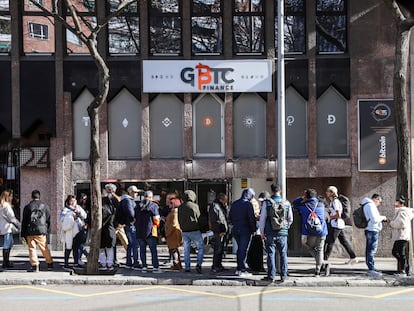$400,000 a year to be a supermarket manager: The salary that accentuates the wage gap in the US
The American supermarket chain Walmart rewards its managers with record pay, but its front-line workers struggle under poor working conditions and paltry wages

Walmart managers couldn’t be happier. The company’s CEO, John Furner, announced last February that he will increase their salaries, and add stock grants to their annual compensation packages. Their positions will become among the best paid in the United States and will be remunerated with company shares. These conditions have received international attention — and have evidenced that one can have a good salary without a university degree, since Walmart store managers aren’t required to have gone to college —, but they have also exposed a deeper problem that has long plagued the multinational retail corporation: the huge pay gap between its managers and its rank-and-file workers.
Starting in April, the base salary for Walmart Supercenter managers, the chain’s largest type of store, will rise to $128,000 a year, 9% more than last year. In addition to the new income, they will get up to $20,000 in company stock each year, depending on their performance and the size of the store they are managing, and may be awarded bonuses of up to 200%. All in all, a Walmart manager could earn as much as $400,000 a year, which would place them in the top 5% of the highest paid workers in the country. Managers of smaller stores will receive between $10,000-$15,000 in stock per year and will also see their salaries increased. To put those figures into perspective: in Spain, a supermarket manager makes between 21,000 and 43,000 euros per year, according to the jobs platform Glassdoor.
Despite those raises, Walmart’s rank-and-file workers are paid between $14 and $19 per hour worked. Although this salary exceeds the federal minimum wage defined by law in the U.S., which is $7.25 per hour, the base pay is not enough to make a decent living. MIT’s Living Wage Calculator project, which calculates benchmark values for pay across the country, puts the national average living wage at $22.13 per hour, for a household with only one working adult and no children. Walmart’s hourly wage would only allow for a decent living in the state of West Virginia, whose living wage is $18.94 per hour for a single adult with no children, assuming the worker received the upper limit of the company’s defined wage range. The lower end of the salary range falls below the minimum wage set by 15 states.
Low pay for its front-line workers is one of the pillars of Walmart’s strategy, primarily to maintain the low prices for which it is well-known. In his 1992 autobiography, Sam Walton, the supermarket network’s founder, wrote: “No matter how you slice it in the retail business, payroll is one of the most important parts of overhead, and overhead is one of the most crucial things you have to fight to maintain your profit margin.” According to Nelson Lichtenstein, author of the book The Retail Revolution: How Wal-Mart Created a Brave New World of Business, the founder used to say, “I pay low wages. I can take advantage of that. We’re going to be successful, but the basis is a very low-wage, low-benefit model of employment.” Walmart is the largest employer of people enrolled in U.S. government low-income subsidy programs, such as Medicaid and the Supplemental Nutrition Assistance Program (SNAP), which provides food assistance.
The strategy made the company arguably the most successful supermarket chain in the world, but also established it as a pariah in the labor market. The corporation has a long history of anti-union posturing, including training videos critical of these organizations. In January of this year, Walmart was accused of using illegal measures to prevent worker unionization at a California store. According to the National Labor Relations Board (NLRB), store management threatened workers who distributed pro-union material, in violation of U.S. labor law. Despite decades of attempts by unions, almost none of Walmart’s approximately 4,700 U.S. stores have unionized. The retail giant currently faces at least 21 other worker or union complaints with the NLRB for alleged labor law violations, such as threats and interrogations of workers and unequal enforcement of labor standards against union supporters.
It was only in 2012 that a labor organization dedicated to the company’s workers was created. The United Food and Commercial Workers International Union, one of the largest in the U.S., created a division specifically for the retail network, called the Organization United for Respect at Walmart (OUR Walmart). The company is the only one among its competitors that has not raised its hourly wage to $15. Target and Costco did it in 2020 and 2021, respectively, and even Amazon, which also doesn’t have a good reputation for how it treats its workers, has been paying it since 2018.
The great benefit that low wages provide is the very low prices for which the company offers its products. Guided by the first part of its mission, which is “saving people money so they can live better,” Walmart has gained so much economic strength that inflation rates are down everywhere it operates, especially for food products. The influence generated by its commercial activity led to the creation of the term “Walmart Effect,” which includes both good consequences, such as an increase in employment (Walmart is the largest employer in the world, with more than 2.3 million workers), and bad ones (its arrival anywhere often causes the closure of small businesses around it). Charles Fishman, author of the book that brought the term to fame, writes that the corporation “isn’t subject to market forces because it’s creating them.”
The high salary it will pay its store managers is the latest creation of this huge company that influences so many markets. This super salary will not be far from others that have gone viral in the U.S., such as the Buccee’s network gas station manager (which reached $275,000) and also the NBA mascots (Rocky, the Denver Nuggets’ mountain lion, is paid $625,000 a year). With its more than 3,500 supercenters, Walmart will give many people access to an exclusive salary pantheon, but which is sustained by the low pay of thousands of front-line workers. Perhaps it would be nice if the company could extend the second part of its mission statement to these workers, but its principles make it clear to whom its competencies are directed: “We help our customers stretch their paychecks and provide for their families.”
Sign up for our weekly newsletter to get more English-language news coverage from EL PAÍS USA Edition
Tu suscripción se está usando en otro dispositivo
¿Quieres añadir otro usuario a tu suscripción?
Si continúas leyendo en este dispositivo, no se podrá leer en el otro.
FlechaTu suscripción se está usando en otro dispositivo y solo puedes acceder a EL PAÍS desde un dispositivo a la vez.
Si quieres compartir tu cuenta, cambia tu suscripción a la modalidad Premium, así podrás añadir otro usuario. Cada uno accederá con su propia cuenta de email, lo que os permitirá personalizar vuestra experiencia en EL PAÍS.
¿Tienes una suscripción de empresa? Accede aquí para contratar más cuentas.
En el caso de no saber quién está usando tu cuenta, te recomendamos cambiar tu contraseña aquí.
Si decides continuar compartiendo tu cuenta, este mensaje se mostrará en tu dispositivo y en el de la otra persona que está usando tu cuenta de forma indefinida, afectando a tu experiencia de lectura. Puedes consultar aquí los términos y condiciones de la suscripción digital.
More information
Archived In
Últimas noticias
Welcome to the post-religion era: The idea of Christianity as the absolute truth has become obsolete
‘I thought you would like it’: The risky sexual practice popularized by TV shows and TikTok
The digitalization of tourism: ‘They promise experiences and gave us the worst possible one’
Mexican peso defies uncertainty with forecasts of a new period of stability in 2026
Most viewed
- Sinaloa Cartel war is taking its toll on Los Chapitos
- Reinhard Genzel, Nobel laureate in physics: ‘One-minute videos will never give you the truth’
- Oona Chaplin: ‘I told James Cameron that I was living in a treehouse and starting a permaculture project with a friend’
- Why the price of coffee has skyrocketed: from Brazilian plantations to specialty coffee houses
- Silver prices are going crazy: This is what’s fueling the rally











































